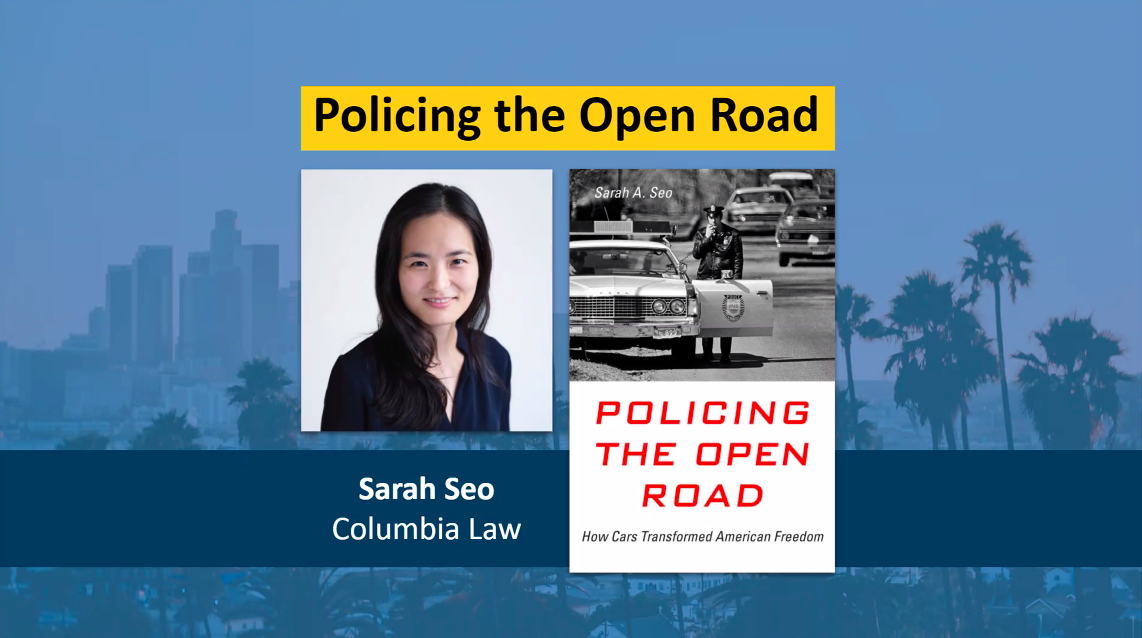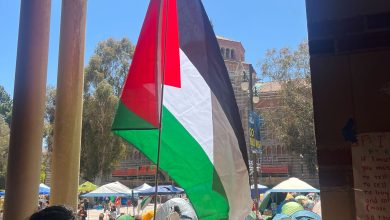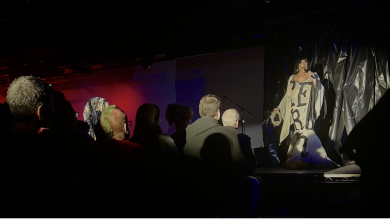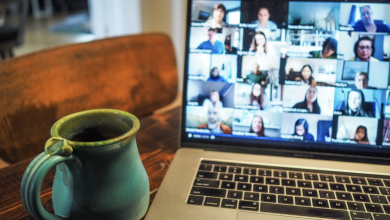Policing the Open Road: The Automobile Paradox

Image Description: A screenshot of a blue powerpoint slide with buildings and trees in the background. At the top of the slide there is text highlighted yellow that reads, ” Policing the Open Road.” In the center-left there is a photo of a person with text underneath that reads, “Sarah Seo, Columbia Law.” In the center-right there is a photo of a police officer standing near a police vehicle and speaking into a walkie talkie. Underneath there is red text that reads, “Policing The Open Road, How Cars Transformed American Freedom.”
In Prairie View, Texas on July 10 2015, a police officer pulled over Sandra Bland for not signaling a lane change. The seemingly small violation led to a traffic stop, which quickly turned hostile, violent, and led to Bland getting arrested. She was found dead in her jail cell three days later. Her death was ruled a suicide yet her family and many others dispute this. The case received international attention and intensified outrage over the treatment of Black people by the police. Columbia Law Professor Sarah Soe wrote “Policing the Open Road” which was published after the incident and is essentially a historical analysis that asks the question: how did we get here?
UCLA Luskin School of Public Affairs hosted the Wach’s Distinguished Lecture: Policing the Open Road on March 4, 2021 for professor Sarah Seo to present on her research that connects the development of the automobile with aggressive policing. “Policing the Open Road” argues that automobiles fundamentally changed the meaning of freedom and normalized pervasive policing. In this lecture, professor Soe summarized her research by dividing the timeline into categories: the paradox, the history, the legacy, and the present.
The automobile became a paradox in American society. On the one hand, cars represented freedom. Cars gave people the ability to go anywhere they wanted and expanded possibilities for work opportunities. On the other hand, cars fundamentally changed the nature and reach of police work, thus disrupting and restricting freedom. Today, cars represent one of the most policed aspects of present life. Only a small percentage of the population has been arrested or has had their home searched, but almost everyone has been pulled over.
Prior to the rise of the automobile, the United States had been an entirely walking society, and it took a while for people to adjust. Traffic, in the early years of the automobile, was created by people walking in streets at all times, which prevented cars from moving any faster than the pedestrians that blocked their path. This created a big problem for the industry, because they wanted automobiles to have complete access to the roads. Additionally, the traffic caused problems for city officials, as people were getting injured and killed in car-related incidents. They needed to create car laws. The professor noted that before this time, white Americans were self-governed for the most part. Churches and other social and community groups enforced and defined moral norms and societal rules. While police existed, they were limited in numbers, and primarily policed the poor and minority communities. After failed attempts to use the same self-governance methods with automobiles, cities quickly realized that they needed a new force of governance. The solution for states was to create a police force that enforced traffic laws.
As soon as police were meant to police everyone, there was an immediate call for police to be courteous and respectful. It was taught in police training classes, written into law, and became a big part of policing protocol. Even the New York Police Department’s motto, which was printed on some NYPD police vehicles, was courtesy, professionalism, and respect.
This push for courtesy did not extend beyond white Americans and did not stop the discriminatory policing and harassment that Black people faced from the police. The new traffic police, with greater authority and in larger numbers, terrorized Black people during the Jim Crow era. Policing of Black Americans was violent, aggressive, and never-ending. Professor Soe shared several clips from a documentary that showed police aggression toward the Black community during the early years of traffic policing. There was a scene of a young Black man standing next to his vehicle while being questioned by the police. The narrator describes the harsh reality: it was almost impossible for a Black person to leave the police stop without a fine and maybe even injuries. The police would check for everything, investigating every inch of the vehicle in hopes of finding something that violates the safety regulations. Professor Soe explained that these checks were very taxing on Black Americans, who were often too poor to keep their cars up to the demanding safety regulations and couldn’t afford the pricey tickets either.
With the increasing presence of the police, the strategy of the law-abiding criminal was created. Traffic enforcement was used as an avenue for pursuing criminal investigations. Anyone pulled over could be a potential criminal, so police protocol was to look for outstanding warrants, look for evidence of auto theft or any criminal activity. It was a tactic that was successful and functioned as a loophole around the Fourth Amendment. The Fourth Amendment protects against unreasonable searches and seizures and requires a warrant to be supported by probable cause. However, with traffic violations, a police officer can pull someone over for a common offense and end up catching a criminal. Police officers are trained that no violation is too small. This tactic was used regularly against Black Americans and is still employed to this day.
Sarah Seo has been advocating for removing the enforcement of civil traffic laws from the jurisdiction of police officers and the reallocation of this responsibility to unarmed personnel in a separate agency. The separate agency would focus only on road safety and would not be tasked with the enforcement of criminal laws. This solution would designate traffic stops as public safety issues rather than a tool for police officers to exploit as investigative stops, which have led to deadly police encounters and unnecessary aggression.




